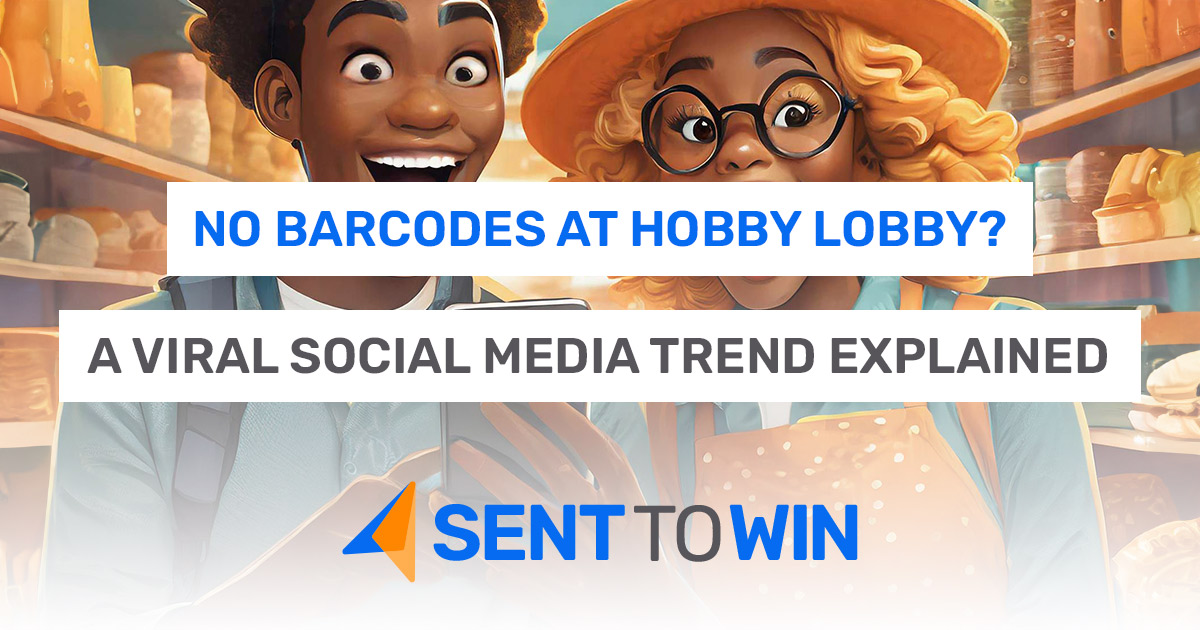No Barcodes at Hobby Lobby? A Viral Social Media Trend Explained
In today’s newsletter:
- No Barcodes at Hobby Lobby? A Viral Social Media Trend Explained
- Inflation Report Jolts Markets, Franchise Fatigue, and Religious Demographics in 2024
- 7 Building Blocks – Why the 4 Ps of Marketing Are not Enough
There’s no shortage of misinformation on the internet, and from time to time, you hear something that just sounds too odd to be true. That has been the reaction of many people when watching recent videos on social media that purport to show a Hobby Lobby shopping hack: Not all (identical) items have the same price.
“Ok, so I’ve seen the TikTok where the same items have different prices in Hobby Lobby… I thought it wasn’t true, but I had to return some things, so I wanted to check for myself,” a video by a user called bowhuntress begins. She then went to check the price tags on identical items, and sure enough, she found many instances of price discrepancies. A sign could be $39.99 or $49.99, depending on which one you happen to grab. “Check those prices before you buy the most expensive one,” she says.
This isn’t the only video like this, and cashiers who work at Hobby Lobby have confirmed – there really are price discrepancies in the store.
The natural next question is this: Since Hobby Lobby is a well-run, national chain that has been operating for over five decades, how could something like this happen?
And why?
Barcodes and the Beast
In the 70s and 80s, when widespread adoption of barcode technology was first happening, a rather silly theory spread around Christian circles that the barcode was the mark of the beast spoken of in Revelation 13. Never mind that the barcodes don’t typically say “666,” the passage from the Bible says that the number 666 is the “number of a man” (and not the mark of the beast), and no one gets a barcode tattooed on their forehead or hand… there was a little bit of hysteria for a while. Even today, this idea comes up from time to time, and a rumor has spread for years that this is the reason why Hobby Lobby doesn’t use barcodes.
Spoiler alert – that’s not the reason.
It is well known that Hobby Lobby Founder David Green is a conservative Christian, and because of that, Hobby Lobby’s conspicuous lack of barcodes seemed to fit the narrative, but, aside from a Snopes article debunking this rumor, David Green has actually written about why he doesn’t use barcodes in his stores. This is his list of reasons, printed in his 2005 book More than a Hobby:
1. Human beings can’t read a bar code.
2. A lot of our products come from cottage industries in Asia that couldn’t mark their goods with bar codes if they tried.
3. Inventory control by computer isn’t as accurate as you think.
4. Employees take more pride in their work when they know they are in charge, not some faceless machine.
5. Customer service is better.
6. The time savings at check-out is minimal – and easily squandered.
7. Reprogramming the computer for sales would take a huge effort in our case because we put so many individual items on sale each week.
8. Twenty million dollars is a lot of money.
With improvements in POS technology, many of those reasons may no longer be relevant. For example, putting an item on sale may not be quite as difficult as he makes it sound for many retailers. But the truth of the matter is barcodes can be confusing, and they have limitations. Hobby Lobby handles approximately 80,000 SKUs, which is more than a grocery store but just a little more than half of what a typical Walmart handles.
Nevertheless, David Green seems to have business-related reasons for choosing not to use barcodes – not theological reasons.
$7.99 at Hobby Lobby… Or Possibly $14.99
So why the price discrepancies? Apparently, due to their unique approach to POS, items are priced based on what shipment they come in on. As inflation occurs, or some other externality, and they have to raise their prices, they only raise prices on the new shipments – even if that shipment contains identical items to lower-priced products already in stores.
Cashiers have to enter every product code by hand at Hobby Lobby (the long waits at check-out are starting to make sense…), and they have to memorize all of the sales items so they know how to discount them manually. Keep an eye on your tally, in other words, and search through the bin for the lowest-priced item if you’re trying to save a few bucks. And, apparently, cashiers will usually honor the lowest-priced item if you are buying more than one of anything that happens to have inconsistent pricing.
This shopping hack turns out to be true.
So Why Does Everyone Else Use Barcodes?
Barcodes really do save a tremendous amount of time, and while they don’t solve all of a business’s inventory woes, there aren’t a lot of great reasons not to use them unless you count the fact that QR codes are starting to replace barcodes.
QR codes are rapidly gaining popularity due to their ability to store larger amounts of information, their ability to be scanned when damaged up to 30%, their ability to be scanned by anyone with a smartphone, and the fact that they are much easier to edit/change.
So maybe Hobby Lobby was just holding out for better technology all this time. But you still better check the prices.
INDUSTRY INSIGHTS
Inflation Report Jolts Markets, Franchise Fatigue, and Religious Demographics in 2024
Inflation Report Jolts Markets
A new consumer price index report from the U.S. Bureau of Labor Statistics hit last week, causing the stock market to (at least momentarily) halt its unprecedented rally. Energy costs, which have been trending downward for most of the year, saved the overall CPI from looking even worse, but even still, investors were given pause. The food index rose 0.4% in January, energy services increased 1.4% (despite energy itself decreasing 0.9%), and piped gas services saw the greatest increase, at 2% for the month. Other services were up 0.7%, including shelter costs increasing 0.6%, transportation costs increasing 1%, and medical services increasing 0.7% last month. The cost of used cars dipped dramatically in January, as you would expect, as did the cost of gasoline and fuel oil. The unadjusted 12-month CPI currently sits at 3.1%. Mortgage rates shot up, in part, in response to the new report.
Franchise Fatigue
Just two months ago, Forbes declared that superhero movies, once a guaranteed slam-dunk investment, were no longer a sure thing. That appears to have been an understatement. Last week, the newest installment in Sony’s Spiderman franchise, a movie starring Dakota Johnson called Madame Web, set the record for the worst opening in the franchise’s history, at just $25.8 million in its six-day opening across two holidays – Valentine’s Day and Presidents’ Day Weekend.
If you only count the weekend, Madame Web brought in just $17.6 million (compared with past successes like Spiderman: No Way Home, which opened to $260 million). But it isn’t just Sony. Disney/Marvel’s releases have been steadily performing worse and worse as well, with the most recent release, The Marvels, setting the record for “lowest grossing MCU movie in history.” Over the entire box office run, it pulled in $197 million globally (less than its budget – and that isn’t even factoring in the mammoth marketing costs), compared with the previous Captain Marvel film, which grossed over a billion dollars worldwide, back in 2019. DC’s last release fared somewhat better, as Aquaman and the Lost Kingdom has rallied past a middling opening weekend to a total gross of over $400 million – but that sounds better than it is, as the movie’s budget was over $200 million, and there are those pesky marketing costs.
At best, it is a moderate success for the franchise, whose previous installment saw well over $1 billion worldwide back in 2018. There will continue to be some winners going forward – Deadpool 3 is likely to win big at the box office, for example – but as the duds pile up (and the losses), we may begin to see a slowdown of the superhero economy in popular culture.
Religious Demographics in 2024
Depending on which survey results you listen to, Gen Z is either just barely hanging onto a Christian majority or is officially majority atheist/agnostic/no religion in particular. What seems undisputed is the rise of the “nones,” those who claim no religious affiliation or label whatsoever (26% among Gen X, 31% of Millennials, and 34% of Gen Z). Among the U.S. population as a whole, fully 28% are now religiously unaffiliated.
These results seem bleak for the faithful, but some experts attest that we don’t understand what “the nones” really are. Despite having no religious affiliation, something like 70% of the no religion believes in God or a higher power, and over 60% believe in something spiritual beyond the natural world, though as a group, they rarely attend religious services or pray, according to survey data. This is, perhaps, part of a larger cultural trend of increasingly segmented subcultures, a lack of faith in institutions generally, and an increased difficulty of categorizing individuals as wholesale members of a given group. Research suggests, understandably, that mass marketing is not likely to work on Gen Z in the way that it has worked on previous generations.
Sunday School
Q. In Mark 12, when the Sadducees question Jesus about the 7 brothers who keep marrying the same woman and dying, what 2nd Temple text are they referencing?
A. The Book of Tobit

Due to an unfortunate misunderstanding, the head of marketing and the lead engineer got into a heated debate.
TIPS & TRICKS
7 Building Blocks – Why the 4 Ps of Marketing Are Not Enough
Most businesspeople are familiar with the famous “Marketing Mix,” a conception of selling formulated in the 1950s by Harvard Professor Neil Borden. This was further refined by E. Jerome McCarthy into what we now know of as the “4 Ps of Marketing.” These 4 Ps are:
Product: What you are selling is, invariably, part of the marketing. How does it look and perform? What kinds of problems does it solve? What kind of quality are we talking about here?
Price: It has been said that price is the first bit of branding a product gets. When a customer who is unfamiliar with your products or organization sees your product on a shelf in Walmart, they are naturally going to assume that it is a value, money-saving brand if it’s priced lower than comparable products around it. They are going to assume that it is a high quality or aspirational brand if it is the highest priced. How much you charge for something influences the commercial message and the consumer experience.
Place: Distribution is a crucial part of the marketing mix for more than one reason. The first is practical – if you don’t have a method of distribution, people will be unable to buy your product. The second is a branding issue – people are going to make assumptions about your offering depending on where they encounter it. In other words, “place” sheds associations to the products found therein. If a watchmaker sells his or her product in a TJ Maxx, a retail discount store, the average consumer is going to think of it very differently than if he saw it in a Gucci Outlet. Where your product is becomes part of the message and identity.
Promotion: This one should be obvious – We have to get the word out. The content of our messaging, the media that we choose to employ, the slogans, the endorsements, and the discounts all make up a crucial aspect of our marketing. Additionally, who is doing the promotion can be just as important. A grassroots, customer-led promotion may be deemed more reliable than a heavily ad-supported promotion push, but there are pros and cons to each approach.
It is a helpful model for understanding the 4 Ps and deciding how to employ them as part of your broader selling strategy. Unfortunately, it leaves out some key concepts big enough to make the difference between success and failure.
The Missing 3
USC Professor of Marketing and Business Administration Ira Kalb, who ran a successful consulting and training firm, preferred to teach the “7 Building Blocks of Marketing.” It includes the four concepts listed above but adds three others:
- Positioning
- Corporate Image
- Marketing Information Systems (M.I.S.)
Positioning: In a typically crowded marketplace, distinguishing your offering from all of the others is of paramount importance. Positioning is the series of strategic and tactical decisions that you make in order to attach a certain perception to your product. In many ways, this building block ties together the first 4 Ps – it provides a common thread for marketers to use. Is there room in the market for a “tough-guy” version of Product B? Then the fonts will have to say that, the packaging will have to say that, the spokesperson will have to be a tough guy, the pricing should reflect that, etc. Positioning is the intentional associations that you want customers to have when they think of your product, and then you use the other 4 Ps to support these ideas even as they also seek to increase sales. Strong positioning can greatly increase brand loyalty, keep competitors at bay, and help you identify and connect with your target market.
Corporate Image: Corporate Image is similar to positioning in some ways, but instead of merely branding and positioning a product, you are investing in the public perception of your entire organization. It’s no longer a question of simply, “What do people think of Air Jordans?” It’s a question of “What do people think of Nike”? This is something that large corporations understand – and invest in heavily. Among smaller businesses, however, this is often neglected. The utility of investing in a strong corporate image, consisting of awareness, perception, and positioning, is that it makes it easier to brand subsequent products. Apple, for instance, has a strong, clear corporate image. So when Apple Vision Pro was released, consumers already basically knew what to expect, knew how to think of the product, and more readily embraced the technology because there were loyal Apple fans who aligned with the mission, values, and associations put out by the corporation.
Marketing Information Systems (M.I.S.): If you can’t measure it, you’re just guessing. That’s the idea behind the M.I.S. building block. Public perception, tastes, and priorities are always changing. A message that resonated with the Midwest in 2020 might not resonate in 2024. A 50% off sale didn’t affect customer’s perceptions of your product quality the first time you did it, but maybe after the third time, people started to wonder. A Marketing Information System is an integrated technological and analytical protocol that allows you to test, measure, and improve the other six building blocks. This can consist of retargeting cookies, customer satisfaction surveys, focus groups, split tests, and demographic studies. M.I.S. asks – how can I follow up on the impressions my product and/or brand gives to both customers and potential customers? What is working and what isn’t? Insanity is doing the same thing over and over again and hoping that it pays off. Constantly measuring the success of your product, price, place, promotion, positioning, and corporate image is, in contrast, high-level marketing.
Quick Hits
- CNBC reports on what industry experts say retail will look like in 5 years from now.
- Open AI again stuns the tech world by unveiling Sora, its text-to-video application, capable of creating stunning, nuanced visuals with only simple, text descriptions as its input.
- The Armstrong Institute of Biblical Archeology lists the top 10 biblical archeology discoveries of 2023.
- U.S. credit card debt now tops $1 trillion – but are we really surprised?
Guess the Prompt
Our “No Barcodes at Hobby Lobby” graphic was generated using AI prompts. Guess the prompt for your chance to win Sent To Win gear. Just reply to this email with your best guess.
For Kingdom Leaders, By Kingdom Leaders
Bringing Kingdom-minded leaders like you fresh perspectives and insights on business, finance, and leadership trends.








